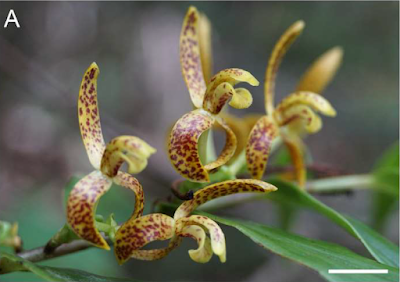Epidendroid Orchids, Epidendroideae, are the largest subfamily of
Orchids, with over 15 000 described species, more than all other Orchid
groups combined. The majority of these species are epiphytic (live on
other plants, typically in the canopy of rainforest trees), though
terrestrial forms are known. The group is found across the globe, with
the exception of the polar regions, the deserts of Africa, Arabia and
Australia, and the southern part of South America. The genus Pseuderia comprises about 20 species of climbing Epidendroid Orchids found in the Moluccas, Micronesia, the Solomon Islands, Fiji, and New Guinea, where the genus reaches its maximum diversity.
In a paper published in the journal Taiwania on 16 August 2019, Zhereeleen Meneses of the Institute of Biological Sciences at the University of the Philippines, and James Cootes of Woodbine in New South Wales, describe a new species of Pseuderia from Samar Island in the Philippines.
The new species is named Pseuderia samarana, in reference to the area where it was found. It is a climbing Orchid that starts as a seedling on the ground, climbs up a tree, and eventually becomes a true epiphyte, losing its original roots and stem and living entirely in the canopy. Pseuderia samarana has blade like leaves and yellow flowers with purple markings born in pairs on short peduncles emerging from the main stems.
Pseuderia samarana: Inflorescences bearing 2 flowers borne on short peduncles. Meneses & Coates (2019).
Pseuderia samarana was found climbing spindly trees on limestone hills in the municipality of Paranas. It was found only at a single location, which lies within the Samar Island Natural Park, which in theory gives it some protection. However, the area is known to have major deposits of copper and gold, and the species occupies a total area of only 0.166 km², with a total population of only 20-30 mature plants, for which reason Meneses and Coates consider the species to be Critically Endangered under the terms of the International Union for the Conservation of Nature’s Red List of Threatened Species.
See also...
Follow Sciency Thoughts on Facebook.







